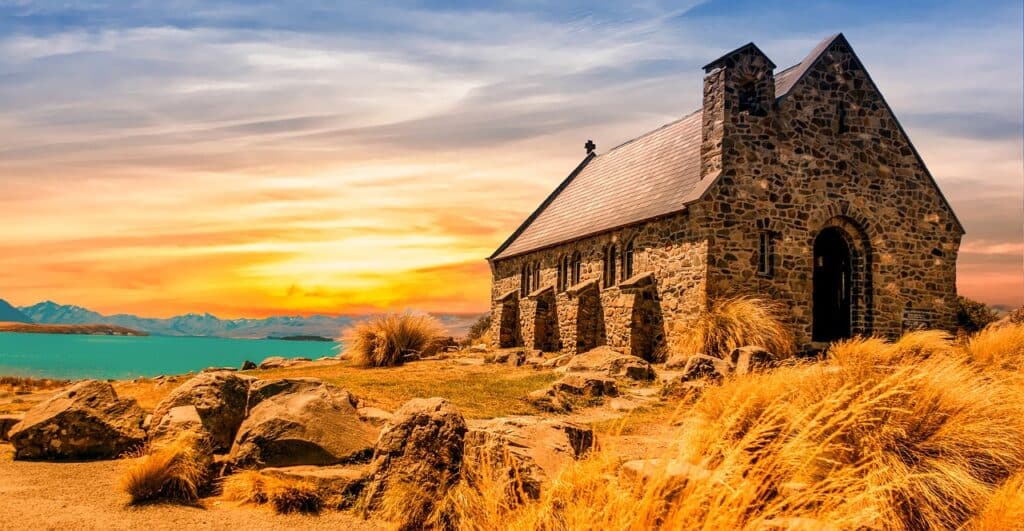Lake Tekapo in New Zealand is a stunning location for photography, known for its incredibly clear night skies, vibrant turquoise waters, and picturesque surroundings. Here are some tips to help you capture the beauty of Tekapo through your camera lens:
- Golden Hour and Blue Hour: Take advantage of the soft, warm light during the golden hour (shortly after sunrise and before sunset) for stunning landscape shots. Additionally, the blue hour (just before sunrise and after sunset) can provide a unique, ethereal quality to your photos.
- Use a Tripod: A stable tripod is essential for capturing long exposures, especially during low light conditions or for night photography. This helps avoid camera shake and allows for sharper images.
- Filters: Consider using a polarizing filter to reduce reflections and enhance the vibrancy of the water and sky. Additionally, a graduated neutral density (ND) filter can help balance the exposure between the bright sky and darker foreground.
- Wide-angle Lens: A wide-angle lens (typically 16-35mm) is excellent for capturing the expansive landscapes around Lake Tekapo. It helps include more of the scenery and creates a sense of depth.
- Foreground Interest: Incorporate interesting foreground elements, like rocks, flowers, or vegetation, to add depth and context to your shots.
- Focus Stacking: For scenes that have both close-up elements and distant subjects, consider using focus stacking to ensure sharpness throughout the frame.
- Night Sky Photography: Tekapo is renowned for its dark skies, making it an excellent spot for astrophotography. Use a fast, wide-angle lens (f/2.8 or lower) and a high ISO setting to capture the stars. Experiment with different exposure times to get the best results.
- Starry Landscapes: Combine a long exposure with the night sky to capture star trails over the lake. This involves leaving the shutter open for an extended period, so a sturdy tripod is crucial.
- Light Painting: Experiment with light painting techniques to add creative elements to your night shots. This can include illuminating foreground objects or creating artistic patterns.
- Time-Lapse: Consider creating time-lapse sequences to capture the changing light conditions or the movement of stars over the lake.
- Weather Considerations: Be prepared for rapidly changing weather conditions in Tekapo. Dramatic clouds, rainbows, or mist can add an extra layer of interest to your photos.
- Post-processing: Use software like Adobe Lightroom or Photoshop to enhance your images. Adjustments to contrast, saturation, sharpness, and white balance can bring out the best in your shots.
- Respect the Environment: Tekapo is a beautiful and ecologically sensitive area. Be sure to follow Leave No Trace principles and any local guidelines or regulations regarding photography.
Remember, while these tips can be helpful, don’t be afraid to experiment and find your own unique perspectives. Every photographer has their own style, and Lake Tekapo offers a wealth of opportunities for creativity.
- What is Midjourney
 Discover the capabilities of Midjourney AI, learn how to effectively utilize the platform, and explore the advantages and disadvantages of the Midjourney AI image generator across its different pricing options.
Discover the capabilities of Midjourney AI, learn how to effectively utilize the platform, and explore the advantages and disadvantages of the Midjourney AI image generator across its different pricing options. - Brand identity elements
 In the vast marketing universe, imagery is pivotal in establishing and nurturing a brand’s identity. A brand’s visual choices are not merely aesthetic decisions but strategic moves that can significantly influence perception and performance. This Picfixs article explores the intricacies of selecting imagery that complements and enhances a brand’s essence, ensuring it resonates with the… Read more: Brand identity elements
In the vast marketing universe, imagery is pivotal in establishing and nurturing a brand’s identity. A brand’s visual choices are not merely aesthetic decisions but strategic moves that can significantly influence perception and performance. This Picfixs article explores the intricacies of selecting imagery that complements and enhances a brand’s essence, ensuring it resonates with the… Read more: Brand identity elements - 100 Best Mountain Captions and Mountain Quotes for Instagram
 Ready to scale new social media heights? Look no further than this treasure trove of 100 exhilarating captions and quotes, handpicked for your Instagram mountain posts!
Ready to scale new social media heights? Look no further than this treasure trove of 100 exhilarating captions and quotes, handpicked for your Instagram mountain posts! - Symmetry in Photography: A Creative Approach with Examples
 Delve into the enchanting realm of symmetry in photography as we showcase mesmerizing examples on our website. Experience the allure of perfectly mirrored images!
Delve into the enchanting realm of symmetry in photography as we showcase mesmerizing examples on our website. Experience the allure of perfectly mirrored images! - 11 Quarantine Photoshoot Ideas to Try at Home for Amazing Photos
 Looking for unique photoshoot ideas during quarantine? Explore the 11 creative suggestions that will help you capture unforgettable moments at home.
Looking for unique photoshoot ideas during quarantine? Explore the 11 creative suggestions that will help you capture unforgettable moments at home.


